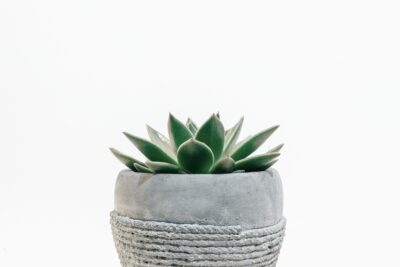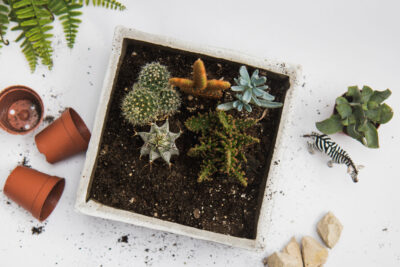
Succulent Size Exploration: Unveiling Their Maximum Growth Potential

Succulents are a popular choice for plant enthusiasts due to their unique ability to store water in their leaves, stems, and roots. These resilient plants have gained popularity in recent years, as they are low-maintenance and come in a variety of shapes, sizes, and colors. However, many succulent owners are often unaware of the maximum growth potential of their plants and how to encourage optimal growth.
We will delve into the world of succulent size exploration, uncovering the factors that influence their growth and revealing how to maximize their potential. We will explore the different types of succulents and their growth habits, as well as the environmental conditions that promote healthy growth. Additionally, we will discuss the importance of proper care and maintenance, including watering, fertilizing, and repotting techniques. By the end of this article, you will have a better understanding of how to help your succulents reach their maximum size and thrive in your home or garden.
- Properly potting succulents can help promote maximum growth potential
- Providing the right amount of sunlight is crucial for succulents to reach their maximum growth potential
- Regularly watering succulents, but not overwatering, can help them grow to their fullest size
- Fertilizing succulents with a balanced plant food can support their maximum growth potential
- Pruning and removing dead leaves can encourage succulents to grow larger
- Repotting succulents into larger containers can allow them to continue growing to their maximum size
- Frequently Asked Questions
Properly potting succulents can help promote maximum growth potential
When it comes to succulents, potting them properly is essential for promoting their maximum growth potential. These resilient plants have gained popularity for their unique shapes, vibrant colors, and ability to thrive in various environments. However, their growth can be hindered if they are not provided with the right potting conditions.
One of the key factors in potting succulents is choosing the right size of the pot. While it may be tempting to pick a small pot to match the compact size of a young succulent, this can restrict its growth potential. On the other hand, an overly large pot may lead to overwatering and root rot. Therefore, it is important to strike the right balance.
Factors to consider when choosing the pot size:
- Maturity: Consider the current size and maturity of the succulent. If it is a young plant, you may opt for a slightly smaller pot, allowing room for growth. For a mature succulent, choose a pot that provides enough space for its roots and allows it to spread naturally.
- Root system: Assess the root system of your succulent. If it has an extensive root system, it will require a larger pot to accommodate its growth. Conversely, a succulent with a more compact root system can thrive in a smaller pot.
- Drainage: Adequate drainage is crucial for succulents to prevent waterlogged soil, which can lead to root rot. Choose a pot with drainage holes to ensure excess water can escape easily.
- Visual appeal: While functionality is essential, you should also consider the aesthetic aspect. Select a pot that complements the unique features of your succulent, enhancing its overall appearance.
It is worth noting that succulents are known for their ability to adapt and tolerate different pot sizes. However, providing them with the optimal conditions will help unleash their maximum growth potential. By understanding the factors that influence pot size selection and considering the specific needs of your succulent, you can create an environment where it can thrive and flourish.
 Optimal Growth of Succulents: Sun or Shade Preference?
Optimal Growth of Succulents: Sun or Shade Preference?Providing the right amount of sunlight is crucial for succulents to reach their maximum growth potential
When it comes to succulent care, one of the most important factors to consider is providing the right amount of sunlight. Succulents are known for their ability to thrive in dry and arid conditions, but they still require sunlight to reach their full growth potential.
Understanding the sunlight requirements
Succulents are native to regions with bright and intense sunlight, so it's crucial to replicate those conditions as much as possible. Most succulents require at least 6 hours of direct sunlight each day to grow and thrive. Without enough sunlight, succulents may become etiolated, meaning they stretch out and become weak and leggy.
Choosing the ideal location
When deciding where to place your succulents, consider the direction and intensity of the sunlight in your area. South-facing windows or balconies are usually the best spots to provide the necessary sunlight. If you don't have access to direct sunlight, you can also use artificial grow lights to supplement the light requirements of your succulents.
Protecting succulents from intense sunlight
 Expert Guide: Cultivating Succulents at Home
Expert Guide: Cultivating Succulents at HomeWhile succulents thrive in sunlight, it's important to note that excessive heat and intense sunlight can also harm them. If you notice signs of sunburn, such as discolored or shriveled leaves, it's essential to provide some shade or move the succulent to a location with indirect sunlight.
Rotating succulents for even growth
To ensure that your succulents grow evenly, consider rotating them every few weeks. This practice allows all sides of the plant to receive an equal amount of sunlight, preventing it from leaning towards the light source and promoting a balanced growth pattern.
Monitoring and adjusting sunlight exposure
Every succulent has its own sunlight preferences, so it's crucial to monitor their growth and adjust their exposure accordingly. If you notice signs of overexposure, such as leaf discoloration or wilting, consider moving the succulent to a spot with slightly less sunlight. On the other hand, if you see your succulent stretching towards the light, it might indicate insufficient sunlight.
Providing the right amount of sunlight is vital for succulents to reach their maximum growth potential. Understanding their sunlight requirements, choosing an ideal location, protecting them from intense sunlight, rotating them for even growth, and monitoring their exposure are key elements in ensuring the healthy development of your succulents.
Regularly watering succulents, but not overwatering, can help them grow to their fullest size
When it comes to succulents, one of the most common misconceptions is that they are small and don't grow much. However, with the right care and attention, succulents can actually reach their maximum growth potential and surprise you with their size.
 Do Succulents Require Full Sun for Optimal Growth and Health?
Do Succulents Require Full Sun for Optimal Growth and Health?To achieve this, it is essential to provide succulents with the proper amount of water. While succulents are known for their ability to store water, they still require regular watering to thrive. However, overwatering can be detrimental to their growth, so finding the right balance is crucial.
When watering your succulents, it's important to pay attention to their specific needs. Some succulents prefer drier conditions, while others thrive in slightly more moisture. Research the specific type of succulent you have to determine its watering requirements.
Using well-draining soil is also essential for succulent growth. This type of soil allows excess water to flow out, preventing the plant's roots from sitting in water and potentially rotting. You can easily find specialized succulent soil mixtures that provide the perfect balance of drainage and moisture retention.
Additionally, providing adequate sunlight is crucial for succulent growth. Most succulents thrive in bright, indirect light, but some varieties can tolerate direct sunlight. Place your succulents near a window where they can receive a few hours of sunlight every day, or use grow lights to supplement their light requirements.
Regularly fertilizing your succulents can also promote their growth. Choose a balanced fertilizer specifically formulated for succulents and follow the recommended dosage. Applying fertilizer during the growing season, typically spring and summer, will provide the necessary nutrients for healthy growth.
Pruning can also play a role in maximizing succulent size. While succulents naturally grow in a compact manner, removing dead leaves and trimming leggy stems can encourage new growth and a fuller appearance.
Finally, do not underestimate the importance of patience. Succulents are not known for their rapid growth, and it may take months or even years for them to reach their maximum size. However, with consistent care and attention, you will be rewarded with stunning, thriving succulents that showcase their full growth potential.
 Understanding the Lowest Tolerance Temperature for Succulents
Understanding the Lowest Tolerance Temperature for SucculentsFertilizing succulents with a balanced plant food can support their maximum growth potential
When it comes to cultivating succulents, one of the key factors that directly influences their growth potential is the type of fertilizer used. Providing succulents with a balanced plant food can significantly enhance their growth and overall health.
Why is fertilizing important for succulents?
Succulents have unique growth patterns and nutritional needs, making fertilization a crucial aspect of their care. While these resilient plants are known for their ability to survive in harsh conditions, they still require essential nutrients to thrive and reach their maximum growth potential. Fertilizing succulents ensures that they receive the necessary elements to support healthy growth, vibrant colors, and strong root development.
Choosing the right fertilizer for succulents
Not all fertilizers are suitable for succulents, as their nutrient requirements differ from those of other plants. It is important to select a balanced plant food specifically formulated for succulents. These fertilizers typically have a lower nitrogen content and higher levels of phosphorus and potassium, which promote root development and flower production.
Additionally, it is recommended to use a slow-release fertilizer for succulents. Slow-release fertilizers gradually release nutrients over time, preventing the risk of over-fertilization and potential damage to the plants.
How to fertilize succulents
Before fertilizing your succulents, it is essential to ensure that the soil is moist. Applying fertilizer to dry soil may result in burns or damage to the plant's roots. Once the soil is adequately moist, follow these steps:
- Choose the right time: Fertilize your succulents during their active growing season, typically in spring and summer. Avoid fertilizing during the dormant period in winter.
- Measure the fertilizer: Follow the instructions on the packaging to determine the appropriate amount of fertilizer to use. It is better to under-fertilize than to over-fertilize succulents.
- Apply the fertilizer: Gently sprinkle the fertilizer around the base of the plants, ensuring that it does not come into direct contact with the leaves or stems.
- Water thoroughly: After applying the fertilizer, water the plants thoroughly to allow the nutrients to penetrate the soil and reach the roots.
Monitoring and adjusting fertilizer application
Regularly monitor the growth and appearance of your succulents to determine if they are receiving adequate nutrition. If the plants exhibit signs of nutrient deficiencies or excessive growth, it may be necessary to adjust the fertilizer application.
 Choosing the Right Light for Succulents: A Guide to Optimal Growth
Choosing the Right Light for Succulents: A Guide to Optimal GrowthRemember, every succulent species has unique requirements, so it's essential to research specific care guidelines for the varieties you own. By fertilizing your succulents with a balanced plant food and monitoring their growth, you can unlock their maximum growth potential and enjoy thriving, healthy plants.
Pruning and removing dead leaves can encourage succulents to grow larger
When it comes to succulent care, one important aspect to consider is pruning. Pruning involves the removal of dead leaves and stems from your succulent plant. Not only does this help maintain the overall health of the plant, but it can also encourage your succulents to grow larger.
Why is pruning important for succulent growth?
Pruning plays a vital role in succulent growth as it removes any damaged or dead parts of the plant. Dead leaves and stems can hinder the growth of healthy parts, diverting resources and energy that could be used for new growth. By pruning regularly, you allow your succulent to focus its energy on healthy leaves and stems, allowing them to reach their maximum growth potential.
How to properly prune your succulents:
- Inspect your succulent: Before you start pruning, carefully examine your succulent plant. Identify any dead or damaged leaves and stems that need to be removed.
- Use clean, sharp tools: It is essential to use clean and sharp pruning tools to minimize the risk of infection. Sterilize your tools with rubbing alcohol before and after use.
- Remove dead leaves: Gently pluck or trim away any dead or shriveled leaves. Be careful not to damage the healthy parts of the plant.
- Trim dead stems: If you notice any dead or rotting stems, use clean pruning shears to remove them. Make sure to cut back to healthy tissue.
- Dispose of pruned parts: It's crucial to properly dispose of the pruned leaves and stems. You can either compost them or throw them away.
Additional tips for encouraging growth:
 Drought-Tolerant Cacti & Succulents: Discover Low-Water Plants
Drought-Tolerant Cacti & Succulents: Discover Low-Water Plants- Provide adequate sunlight: Succulents thrive in bright light conditions, so make sure they receive enough sunlight. Place them near a window with indirect sunlight or use grow lights if necessary.
- Water sparingly: Overwatering can lead to root rot and hinder growth. Succulents prefer well-draining soil and should be watered only when the soil is completely dry.
- Provide proper nutrition: Succulents benefit from occasional fertilization during their active growth phase. Use a balanced fertilizer specifically formulated for succulents and follow the instructions carefully.
By incorporating regular pruning into your succulent care routine and following these additional tips, you can unlock the maximum growth potential of your succulent plants. Remember, a little TLC goes a long way in helping your succulents thrive and reach their full size!
Repotting succulents into larger containers can allow them to continue growing to their maximum size
One of the key factors in the successful growth of succulents is providing them with adequate space to flourish. While these resilient plants are known for their ability to thrive in compact containers, repotting them into larger pots can unlock their true growth potential.
Succulents, with their fleshy leaves and water-storing capabilities, have evolved to adapt to harsh and arid environments. However, even though they can survive in small containers for extended periods, their growth may become stunted without sufficient room for their roots to spread and access water and nutrients.
When you repot a succulent into a larger container, you are essentially giving it a chance to stretch its roots and reach for more resources. This additional space not only promotes better root development but also allows the plant to grow bigger and healthier.
Benefits of repotting succulents into larger containers
Repotting succulents into larger containers offers several advantages:
- Enhanced root growth: With more space, succulents can develop a robust root system that efficiently absorbs water and nutrients from the soil.
- Improved water retention: Larger pots have a greater capacity to hold water, reducing the risk of underwatering and ensuring consistent hydration for your succulents.
- Increased nutrient availability: A larger pot allows for a more substantial amount of soil, which can hold a greater quantity of nutrients and provide a nutrient-rich environment for your plants.
- Prevention of root-bound issues: Over time, succulents grown in small pots may become root-bound, where their roots become tightly packed and entangled. Repotting into a larger container prevents this issue and promotes healthier root growth.
- Long-term growth potential: By providing adequate space for your succulents to grow, you are ensuring their long-term health and enabling them to reach their maximum size.
When should you consider repotting your succulents?
Knowing when to repot your succulents is crucial to their growth and overall well-being. Here are some signs that indicate it might be time to consider repotting:
 Optimal Sunlight Duration for Succulents: How Much is Enough?
Optimal Sunlight Duration for Succulents: How Much is Enough?- Roots outgrowing the container: If you notice roots poking out from the drainage holes or circling the inner edges of the pot, it's a clear indication that your succulent needs a larger container.
- Slow growth or stunted appearance: If your succulent is not showing signs of growth or looks compacted and overcrowded, repotting it into a larger pot can provide the necessary space for it to thrive.
- Frequent watering: If you find yourself watering your succulent more frequently than usual, it may be a sign that the current pot is not retaining enough moisture, and repotting into a larger container can help alleviate this issue.
Remember, repotting your succulents into larger containers should be done with care. Choose a pot that is only slightly larger than the current one, as a pot that is too big can lead to overwatering and root rot. Use well-draining soil specifically formulated for succulents to ensure proper water flow and prevent waterlogged roots.
By repotting your succulents into larger containers, you are providing them with the space they need to reach their maximum growth potential. Not only will they have healthier roots and better access to water and nutrients, but they will also exhibit stunning growth and become the focal point of your indoor or outdoor space.
Frequently Asked Questions
1. How big do succulents typically grow?
Succulents can vary in size depending on the species, but most commonly they grow to be around 2-6 inches tall and wide.
2. Is it possible for succulents to grow larger than their typical size?
Yes, some succulents have the potential to grow larger than their typical size, especially when provided with optimal growing conditions and ample space.
3. What factors can influence the growth of succulents?
Accelerate Succulent Growth: Unveiling Tricks for DevelopmentFactors such as sunlight exposure, temperature, watering frequency, soil quality, and pot size can all impact the growth of succulents.
4. How can I encourage my succulents to reach their maximum growth potential?
To encourage maximum growth in succulents, provide them with bright but indirect sunlight, ensure proper drainage in their pots, use well-draining soil, water them sparingly but deeply, and avoid overcrowding them in containers.
If you want to read more articles similar to Succulent Size Exploration: Unveiling Their Maximum Growth Potential, you can visit the Growing Conditions category.






You Must Read